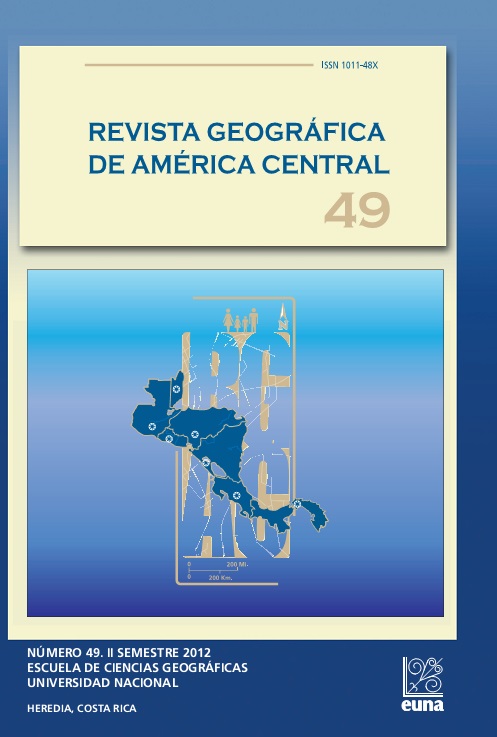HORTICULTURAL LANDSCAPES AND FOOD CULTURE IN GUATEMALA
Keywords:
Agricultural landscapes, indigenous horticulture, Guatemala, eating habits, eating behaviorAbstract
The term landscape is linked to a people´s cultural expression in their land. Therefore technolo-gical changes become visible through the impression they leave on the landscape and changes in people´s practices and food habits. The field investigation was carried out by the author during 2008 and 2009 in the indigenous communities of Almolonga and Zunil in the county of Quetzalte-nango in Guatemala. These communities are mostly involved in agriculture. The concept of landscape allows an approximation of geographical space as well as the evolution of technical and organizational methods in the field of indigenous subsistence agriculture. Horti-cultural cultivation in this area, with particularly favorable conditions due to its volcanic soils and availability of water, has become exposed to the market and techniques requiring ever more inten-sive use of resources. This investigation demonstrates the difficulties facing subsistence farmers exposed to intensive production systems. On the one hand, natural resources deteriorate and on the other, social cohesion weakens. Rural productive land becomes important when demonstrating the link between this and food culture. The loss of a landscape is no more than a technical and production change as well as signaling a lack of marks of identity, for example food. One turns to the renewal of food practices and habits by marking food as a completely social act that highlights social inequalities caused by the current global agro-food system, something that is questioned throughout the article.
References
Aguirre, B.G. (1984). Producción de alimentos y cultura. Cuadernos de
Nutrición 7(2), 17-32.
Alonzo, G. R. (Coord.) (2008). Sistema productivo local de Almolonga,
Departamento de Quetzaltenango, Guatemala. Universidad de San
Carlos Guatemala, Centro Universitario de Occidente, Quetzaltenago,
Guatemala. Recuperado de: http://digi.usac.edu.gt/bvirtual/
investigacio_files/INFORMES/PUIEP/INF-2008-072.pdf
Buxó, R. (2006) Paisajes culturales y reconstrucción histórica de la vegetación. Ecosistemas 15 (1), 1-6. Recuperado de: http://www.revistaecosistemas.net/articulo.asp?Id=408
Condominas, G. (1960). Fokon’olona et collectivités rurales en Imerina. Berger-Lé vrault, Paris, Francia.
Cravioto, R. (1951). Valor nutritivo de los alimentos mexicanos. América Indígena, XI (4), 297-309.
Droeven, E., Dubois, C. & Feltz, C. (2007). Paysages patrimoniaux en
Wallonie (Belgique): analyse par approche de paysages témoins.
Cahiers d’économie et sociologie rurales, (84-85), 216-243.
Elias, N. (1991). La civilisation des moeurs. Paris : Ed. Calmann-Lévy.
Fischler, C. (1995). El (h)omnívoro. El gusto, la cocina y el cuerpo. Barcelona, España: Anagrama. Colección Argumentos.
Harris, M. (1989). Bueno para comer: enigmas de alimentación y cultura. Madrid, España: Alianza Editorial.
Hernández, E. (1987). Xolocotzia. Obras de Efraín Hernández Xolocotzi. (Tomo II). Chapingo, México: Universidad Autónoma Chapingo.
Kirchoff, P. (2002). Escritos selectos. Estudios mesoamericanistas. Volumen I. Aspectos generales. García, C., Manzanilla, L., MonjarásRuiz, J. (eds.). México: Universidad Nacional Autónoma de México. Instituto de Investigaciones Antropológicas. México.
Lipovetsky, G. (2005). El crepúsculo del deber. La ética indolora de los
nuevos tiempos democráticos. Barcelona, España: Anagrama.
Mauss, M. (1950). Sociologie et antropologie. París, Francia: Presses Universitaires de France.
Olivers de Sardin, Jean-Pierre, (2008). La riguer du qualitatif. Les contraintes empiriques de l’interprétation socio-anthropologique.
Louvain-La-Neuve, Bélgica. Bruylant-Academia, S.A.
Organización de las Naciones Unidas para la Agricultura y la Alimentación Representación en Guatemala (2005). Maíz para Guatemala Propuesta para la Reactivación de la Cadena Agroalimentaria del Maíz Blanco y Amarillo. Elaborado por: Fuentes, M. R., Van Etten, J., Ortega, A. y Vivero, J. L. Recuperado de: http://pesacentroamerica.org/biblioteca/02_Maiz_para_%20Guatemala.pdf
Ortiz, A. S., Vázquez, V. y Montes, M. (2004). La alimentación en México: enfoques y visión a futuro. Estudios Sociales, 3(25), 8-35.
Palerm, A. (1990). México prehispánico. Ensayos sobre evolución y ecología. México: Consejo Nacional para la Cultura y las Artes.
Panelli, R. y Tipa, G. (2009). Beyond foodscapes: Considering geographies of Indigenous well-being. Health & Place, 15 (2), 455 - 465.
Poulain, J.-P. (2002). Sociologies de l’alimentation, les mangeurs et
l’espace social alimentaire. Presses Universitaires de France.
Rojas, T. (1990). “La agricultura en la época prehispánica”. La agricultura en tierras mexicanas desde sus orígenes hasta nuestros días. Ciudad de México, México. Editado por Consejo Nacional para la Cultura y las Artes y Editorial Grijalbo. (pp. 5-138)
Wilken, G. C. (1987). Good farmers. Traditional Agricultural Resource
Management in Mexico and Central America. Estados Unidos: University of California Press.
Downloads
How to Cite
Issue
Section
License
Proposed policy for journals offering Open Access
Authors publishing their works in the Journal acknowledge and agree to the following terms:
a) Authors retain the copyrights to their works and guarantee the Journal the right to be the first to publish their works, under the Creative Commons License Attribution-NonCommercial-ShareAlike 4.0 International, CC BY-NC-SA 4.0 International (https://creativecommons.org/licenses/by-nc-sa/4.0/deed.es), which allows others to share works upon complying with the acknowledgment of authorship and mention of the Journal as the original publisher of the work.
b) Authors are permitted to separately establish additional agreements for the non-exclusive distribution of the official edition of the work published in the Journal (for example, authors may desire to place the work in an institutional repository or incorporate it into a book that is to published elsewhere) so long they acknowledgment to recognize the Journal as the original publisher. The aforementioned additional agreements must respect the terms of the non-profit character and sharing philosophy of the original license (CC BY-NC-SA 4.0 International, https://creativecommons.org/licenses/by-nc-sa/4.0/deed.es).
c) Authors are encouraged to archive the post-print or editor/PDF version in Open Access repositories.






 REVGEO is licensed under https://creativecommons.org/licenses/by-nc-sa/4.0/deed.es
REVGEO is licensed under https://creativecommons.org/licenses/by-nc-sa/4.0/deed.es
.svg_4.png)

_(1).png)
_(1)_(1)_(1)_1.png)
(2)(1)(1)(1).png)
